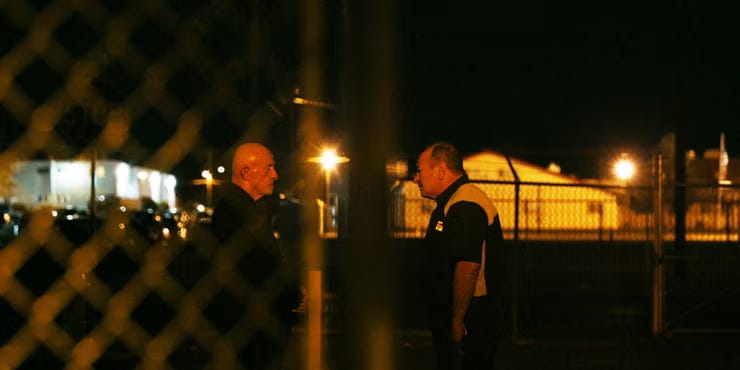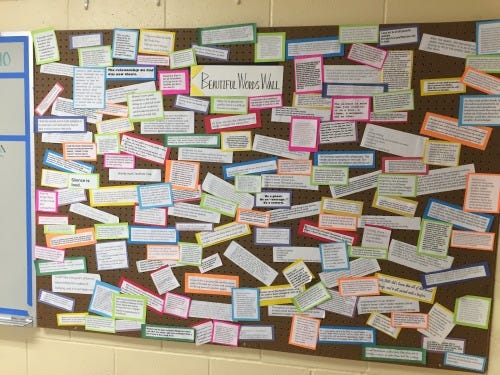Reminder: a Fence Has Two Sides
(and so does a classroom wall)
Morning! It’s Marcus again—and I wanted to lean a bit into one of the reflections I’ve been mulling over more often in the latter half of my first decade of teaching:
How do I balance the need to focus on my own classroom with the desire to also work to improve what is beyond it?
There are many paradoxes within education, and I have observed quite often the contexts within which I’ve found myself straddling over the last decade—stretching to find reconciliation between two countering, “good" intentions
And over-extended (sometimes literally!) and exhausted by the endeavor itself.
“Find a balance” is the type of advice that is much easier to say than adhere to, after all, especially within such paradoxes.
For today, though, I want to spend a bit more time thinking about the ramifications of what happens when a teacher does in fact choose to focus on their own classroom (as I have done A LOT, I’ll admit), to ignore whatever bedlam is ensuing outside and “make their classroom good.”
Let’s begin with an extended analogy:
The fence’s two sides, per Prestige TV
In a recent episode of the remarkable Better Call Saul’s final season, one of its antihero protagonists, Mike Ehrmantraut, attempts to offer a partial peace to the father of the drug dealer, Nacho Vargas, whom he had taken under his wing before watching him fall to the vengeance of the enemy cartel.
Mike’s simple goal: to let Nacho’s father, Manuel, know that his son is no longer alive, and also to assure him that “justice” will be achieved, ultimately.
And is the case with almost every single second of the filming of the masterpiece that is Better Call Saul, the framing of this conversation between Mike and Manuel is both intricate and intentional:
Throughout the conversation (seriously, watch it!), a fence stands between them—and it is filmed to emphasize this fact, often with Mike veiled behind the chain links in the eyes of the viewer, symbolizing how captive he is within the world he has chosen for himself.
The scene ends with Manuel walking away from the promise of “justice” having seen the offer of revenge for what it is: a continuation of the violence and evil of the world he wants no part of.
The message is clear in the fenced framing; Manuel is free, morally, and Mike is bound, immorally.
And yet—there are glimpses in the conversation at which, leaning over Mike’s back shoulder, the camera offers the viewer a perspective of Manuel behind the chain-linked fence, too.
Morality delineations aside, there is a simple, undeniable fact that Better Call Saul seems to insist upon this scene as well:
Fences have two sides.
“Close your door and make your classroom good.”
This is the advice that I have offered to many throughout the first decade of my teaching career, while also adhering faithfully to it myself quite often as well.
The pragmatic humility within it is pretty straightforward. When the things outside your classroom are overwhelming—almost always beyond your control, too—do what you can to “close the door” and focus on what you can control: your own classroom.
This leaning on the boundary of the classroom itself, the closed door and the four walls surrounding your space, is something I have written often about, most recently in one of my reflections leaving Arkansas: I think most about boundaries: those that we create between ourselves, those that we adhere to surrounding us, and those that we refuse in our mind between what was and what is and what will be.
In my early years teaching, “building the wall” was essentially a survival skill.
I’ve told the story many times of a particularly stressful day in my early years, when the intercom interrupted class to announce that “the bench outside the principal’s office is full, so please do not send any more students to the office today.”
The looks exchanged amongst my students in the classroom immediately after that announcement still send shivers up my spine. It was a moment of utter terror for teachers throughout the building.
Which is how I came to appreciate my classroom walls.
Much of those early years, therefore, was about fortifying the culture inside the classroom, with the goal of building something strong enough within the classroom to withstand the chaos beyond it. It takes work to create a good classroom space in those conditions, after all, and through the many roller coasters of those first years teaching I do believe I became much stronger at doing just that:
“Close the door and make your classroom good.”
There is a lot of logic to this type of advice, too:
Locus of control mindset: there is pragmatism in focusing your energy on something more within your control
Emphasis on Classroom Culture: as I’ve written at-length about in the past, it is a good thing to care about your classroom culture and to take ownership of it!
Safe Classroom Space Priority: especially in buildings where not all students are seen and affirmed for their full selves, prioritizing a classroom in which students do indeed feel safe and valued is no small thing at all
But now I think back not only to the Better Call Saul anecdote above, but to the many times that—despite the good occurring within our classroom walls—I had taken the easier path of ignoring the work that needed to be done beyond those walls, “adhering” to the broader context and, implicitly, reaffirming it.
The easier path has consequences, of course.
Another story from another classroom
In my next school in Arkansas, I walked in with much more confidence about how to “reinforce that classroom wall”—and was even told by many going into that position that this particular skill would be essential.
So that’s what I committed to: walking down the long hallway to my room, shutting the door, and making that space the best place it could possibly be for every one of the students.
It was a source of pride, even arrogance, that I could “close my door and make my classroom good.” It had evolved from merely a survival instinct in those first years to part of my teaching identity—something I saw as a strength, but I would have to reconcile with as a weakness as well.
After over a year in that position, I remember doing an exercise in which students reflected on their learning experiences up to that year, and again and again another teacher’s name continued to come up as a transformational figure in their education journey.
A teacher I had gone more than a year without collaborating with, despite the fact that they had far more experience than I did and taught the same subject.
I had to reckon with how I had committed all my energy to walking down that long hallway and closing my door rather than considering what it looked like for colleagues to see me walk past their rooms, to close the door to my room rather than knocking on their doors instead.
Maybe in expending so much “extroverted” energy in the classroom as a teacher, I had too little left to give beyond the classroom. Maybe I had been given bad advice about “reinforcing the classroom wall” and had taken notes of encouragement as permission to opt out of building relationships with more colleagues. Maybe those survival skills had entrenched themselves too deeply in my mindset.
Regardless, I realize looking back that there was a cost to how much I committed to fortifying the classroom wall, especially in what it looked like from the other side.
The other side of the “fence” mattered, too.
But the other side of the classroom wall is…harder?
Of course it is. That is kind of the point.
When you step outside the classroom as a teacher to collaborate with others, advocate for students, and become a part of the broader school culture, this also means forfeiting the perspective of proximity.
You can’t see everything in a school—other teachers have seen and experienced different vantage points than your own, not to mention other colleagues, especially administrators, who are privy to things beyond your purview.
Collaborating also means, at times, doing things that others want to do in order to align better holistically, or compromising away from your own comfort zone as a teacher if the broader school community chooses a different route.
Easier to just close your door and do things your own way, right?
Yet remember the fence from Better Call Saul? Even if you think you are on the “right side” of that fence, the fence is still there.
And that comes with a cost.
So what have I learned?
A few things, I hope, going forward to this school year that I think affords helpful advice to other teachers, too:
It’s not a bad thing to focus on your classroom—but understand that this isn’t enough. Especially for me now, going into decade #2, the “survival instinct” of just keeping my head above water is no longer an excuse to not engage with the broader school culture, to learn from colleagues, and to participate in coalition-building necessary to advocate for students. You cannot be the best teacher you can be within your classroom if you don’t learn to thrive beyond it in your school community.
Your students go to many other classrooms—so you need to as well. In part to understand what their experience is, but also to recognize how your classroom culture exists within the context of a broader school culture. There are so many assets in school buildings, all school buildings, and confining yourself within your classroom walls is a choice to limit what you yourself can do for your students in your own classroom. (example: one of the best experiences of this past school year for our class took place outside of our classroom—which I go into detail about here!)
Yes, you want to define your own classroom culture with your students—yet do so as a part of the broader school community, not apart from it. This means making sure to recognize how each student has so many other spaces that matter to them, not only other classrooms/teachers but also activities, jobs, family, etc. Your classroom should be a place that invites them to bring their full selves into the room, not one that asks them to “check everything else at the door.”
I think I’ve gotten better at these three things in recent years, but I also recognize the work I still have to do—and I hope very much that my second decade of teaching is one in which the classroom wall is much more of a window, one in which I am constantly seeking to look beyond and be a much better part of the broader contexts that classroom is a part of.
Thoughts or Suggestions?
As with all posts here on The Broken Copier, feel free to offer your own feedback—Jim and I are wrong quite often, we realize!—or email us if there’s another perspective to consider or even a topic you’d like us to tackle.
And of course I’d be remiss not to plug our latest podcast episode: a discussion on receiving and reflecting upon test scores over the summer as teachers. I’m proud of a lot of our conversations with this project so far, but this is one of my favorites, quite honestly—and I found it really helpful to be part of.
Thanks as always for your support, too, don’t hesitate to subscribe/share if you haven’t yet, and most importantly, if you’re a teacher reading this, know how much we appreciate you for being in a classroom yourself. In this current moment, that matters a great deal.
Until next time!
—Marcus



